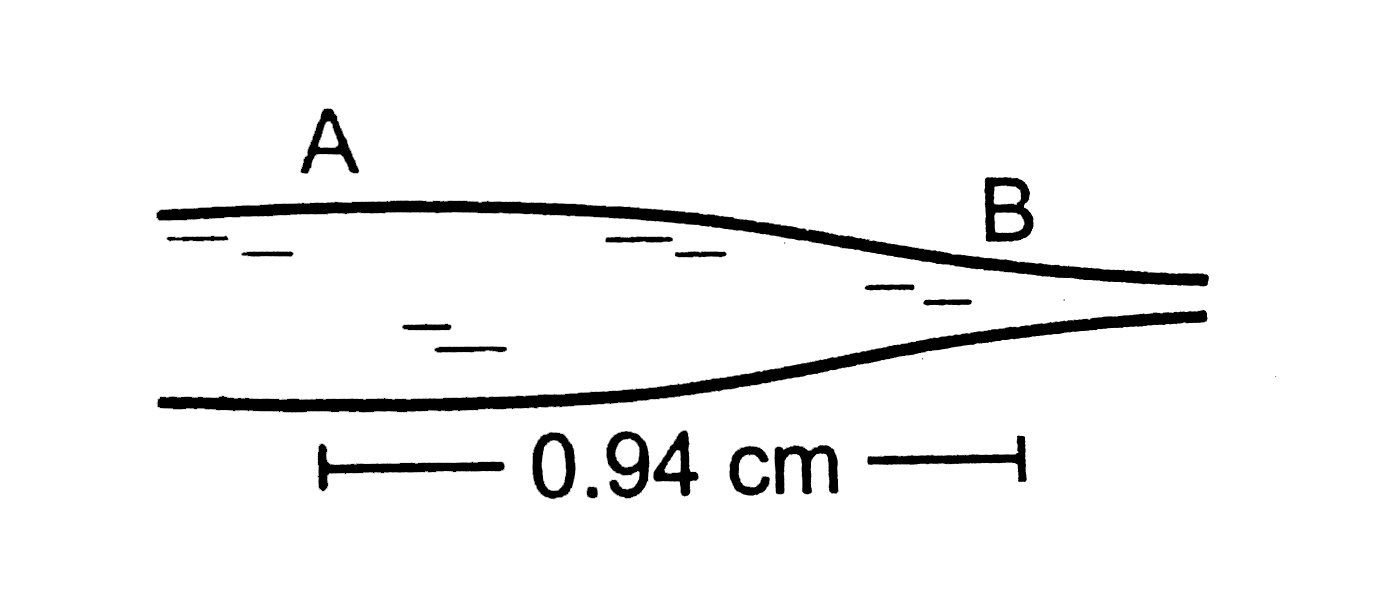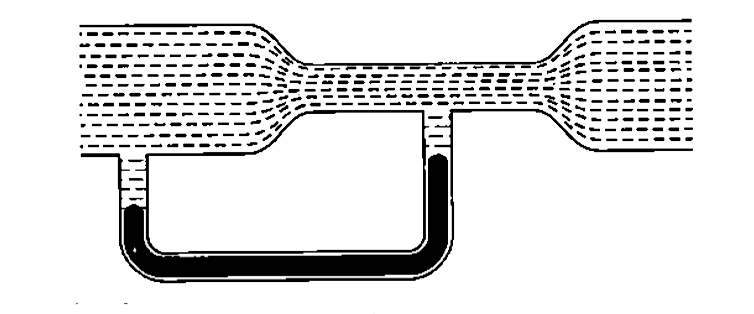Water flows through a tube of non-uniform areas of cross-section. The cross section of the parts A, B and C are 25, 5 and 35 cm2 respectively. Which parts has the highest velocity ?

A
B
conservation of angular momentum
all have same velocity
The correct Answer is:B

For water flowing in a non-uniform tube, we apply the principle of continuity Av= constant.
∴ v∝1A (A is minimum for the part B.)
∴ Velocity of water is maximum in B.
Topper's Solved these Questions
- BOOK - MARVEL PUBLICATIONCHAPTER - FRICTIONAL IN SOLIDS AND LIQUIDS EXERCISE - TEST YOUR GRASP10videos
FRICTIONAL IN SOLIDS AND LIQUIDS
- BOOK - MARVEL PUBLICATIONCHAPTER - FORCE, WORK AND TORQUEEXERCISE - TEST YOUR GRASP10videos
FORCE, WORK AND TORQUE
- BOOK - MARVEL PUBLICATIONCHAPTER - MAGNETIC EFFECT OF ELECTRIC CURRENT EXERCISE - TEST YOUR GRASP10videos
MAGNETIC EFFECT OF ELECTRIC CURRENT
Similar Questions
Water flows through a horizontal tube of variable cross-section. The area of cross section at A and B are 4mm2and2mm2 respectively. If 1 cc of water enters per seconds through. A find a. The speed of water at A, b. the speed of river at B and c. the pressure difference PA−PB.
 View Solution
View SolutionWater flows through a horizontal tube of variable cross section.The area of cross section at A and B are 4 mm2and2mm2 respectively. If 1 cc of water enters per second through A find
a) The speed of water at A
b) the speed of river at B
c) the pressure difference PA−PB.
 View Solution
View Solution
Knowledge Check
- Question 1 - Select One
Water flows through a non-uniform tube of area of cross section A, B and C whose values are 25, 15 and 35cm2 resprectively. The ratio of the velocities of water at the sections A,B and C is
A5:3:7B7:3:5C21:35:15D1:1:1 - Question 2 - Select One
Water flows through a vertical tube of varible cross-section. The area of cross-section at A and B 6 and 3 mm2 respectively. If 12c c of water enters per second through A, find the pressure difference PA−PB.(g=10m/s2). The separation between the cross-section at A and B is 100 cm.
 A1.6×105dyne/cm2B2.29×105dyne/cm2C5.9×105dyne/cm2D3.9×105dyne/cm2
A1.6×105dyne/cm2B2.29×105dyne/cm2C5.9×105dyne/cm2D3.9×105dyne/cm2
Water flows through the tubes shown in figure. The areas of cross-section of the wide and the narrow portions of the tube are 5cm2 and 2cm2 respectively. The rate of flow of water through the tube is 500cm3/s. Find the difference of mercury levels in the U-tube.
 View Solution
View SolutionWaster flows throgh a horizontal tube of variable cross section.The area of cross section at A and B are 4 mm2and2mm2 respectively. If 1 cc of water enters per seconds through. A find a. The speed of water at A, b. the speed of river at B and c. the pressure difference PA−PB.
 View Solution
View SolutionWater flows through the tube shown in figure. The areas of cross section of the wide and the narrow portions of the tube are 5cm2and2cm2 respectively. The rate of flow of water through the tube is 500cm3s−1 . Find the difference of mercury levels in the U-tube.
 View Solution
View SolutionWater flows through the tube shown in figure. The areas of cross section of the wide and the narrow portions of the tube are 5cm2and2cm2 respectively. The rate of flow of water through the tube is 500cm3s−1 . Find the difference of mercury levels in the U-tube.
 View Solution
View SolutionWater flows through the tube shown in figure. The areas of cross section of the wide and the narrow portions of the tube are 5cm2and2cm2 respectively. The rate of flow of water through the tube is 500cm3s−1 . Find the difference of mercury levels in the U-tube.
 View Solution
View SolutionAn ideal liquid (water) flowing through a tube of non-uniform cross section area at A and B are 40cm2 and 20cm2 respectively. If pressure difference between A & B is 700 Nm2 then volume flow rate is
 View Solution
View Solution

